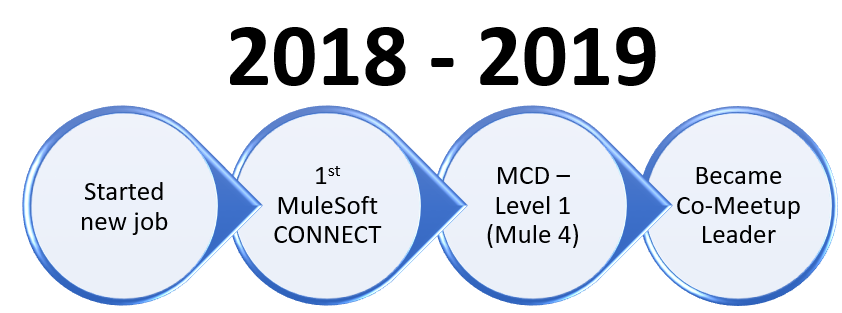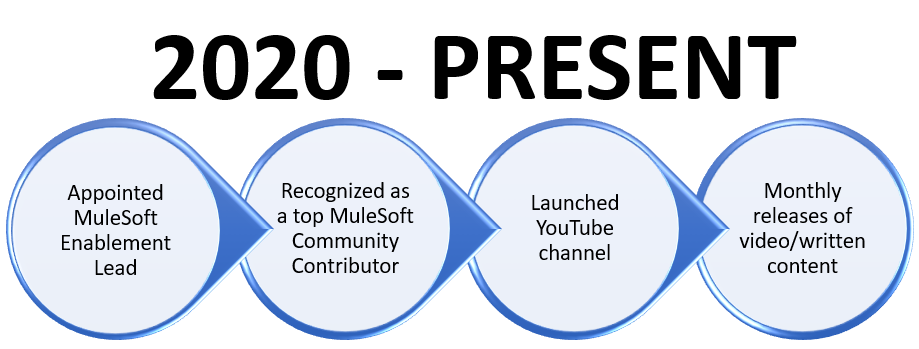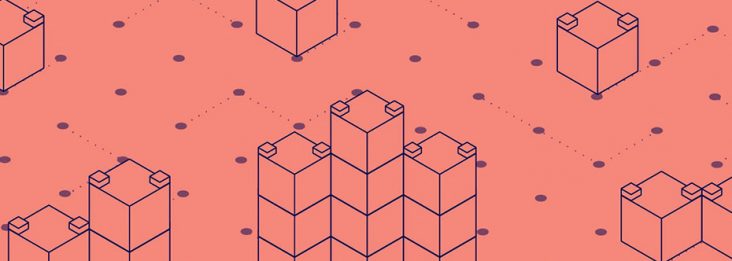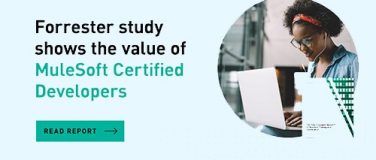Whitney Akinola is a Software Engineering Associate Manager and MuleSoft Enablement Lead for Accenture. Follow Whitney as she summarizes her professional journey advancing from a junior MuleSoft developer to a MuleSoft Enablement Lead, and how she broke into the MuleSoft development sphere. Additionally, she shares her trajectory from a MuleSoft community member to a MuleSoft Meetup Leader and Software Integration Creator, providing advice to those interested in pursuing MuleSoft development.
Humble beginnings
While working for Amtrak back in 2016, I was selected to join a project with legacy technology that I felt would be stagnant for my career growth. Aware of my restless desire for change, my co-worker encouraged me to try MuleSoft and take advantage of their free training resources. MuleSoft carried a reputation at my company for producing top products and subsequently, everyone wanted to learn or become involved in a MuleSoft project.
Reluctant to take up something new, I had delayed this opportunity until the following year before deciding to pursue her advice. In May of 2016, I took my first MuleSoft training course, and like today’s Anypoint Platform Development Fundamentals course, it was self-paced and video-based. I thoroughly enjoyed the course material and opted to get certified without any real-world experience.
At that time, the exams were open book and yet I still managed to fail my first Mule certification exam. Despite initial discouragement, MuleSoft emailed me a post-test breakdown of my score which shared insights for my areas of improvement along with MuleSoft documentation to help. I went from not having a strategy for exam preparation to having access to a detailed analysis of my test performance. Implementing the exam resources and strategy built my confidence and within the same weekend, I attempted a second try. Fortunately, I passed, and from 2016 to 2018, I enjoyed the status and benefits of being a MuleSoft Certified Developer-Integration and API Associate.
MuleSoft Champions
Once I became certified in 2016, I immediately went to my employer and asked to be placed immediately on any open MuleSoft project. However, this did not happen overnight. During that same year, I discovered the MuleSoft Champions program that — at that time — allowed developers to work on coding challenges, get certifications, and engage in quizzes.
In 2018, the Champions program ultimately retired, but it was through this program that I was able to supplement my MuleSoft knowledge, build confidence in my development skills, cultivate love for the company, and a passion for integration. I found Mule to be intuitive and keen on user experience, and continue to build my knowledge by receiving help from my teammates, reviewing MuleSoft documentation, reading blogs, and watching tutorials.
My big break
My desire to continue improving my skillset became a top priority, so I took time off from work and enrolled in the Anypoint Platform Development: Advanced (Mule 3) course, started attending MuleSoft Summits in New York City, and engaged with MuleSoft Meetups in Philadelphia.
Finally, after waiting almost a year, I was placed on my first MuleSoft project: a webMethods to Mule 3 migration. Excited about the opportunity and for my official big break into my MuleSoft journey, I made sure I designated much of my commitment and hard work in achieving a quality project, for both me and my employer.
Fortunately, it was a success! I contributed to my team’s effort of migrating all their webMethods integrations to Mule 3. This accomplishment meant so much to me because this was the first time in my career where I felt truly confident in my work, and that my work directly impacted our customers. I was then immediately placed on a high visibility payments project which enabled customers to utilize various payment methods.

Helping a company to start its MuleSoft journey
Following my payments project, I left my past employer for a new opportunity to help another company bring in Anypoint Platform and Mule Runtime as their enterprise integration platform. I found this remote position to be valuable to my growth as a technical lead because of the various responsibilities I was tasked with. I provided technical insight for contractor work that focused on Tibco to Mule 3 migration, Customer and Employee portals, performing Anypoint Platform admin duties, and developing finance APIs. I also had the opportunity to evaluate Runtime Fabric, develop an integration strategy roadmap, and work with MuleSoft’s Customer Success and my employer’s Architecture teams on sizing and licensing efforts for new projects in the pipeline.
It was simultaneously during this time when I had the chance to attend my first MuleSoft CONNECT conference where I signed up to be the Wilmington, DE Co-Meetup Leader, in addition to passing several advanced MuleSoft certification exams. This trajectory from breaking into external MuleSoft job opportunities and internal MuleSoft events truly helped shape me into a leader.

2019 MuleSoft Connect – NYC with my mentee Jeremy Cotter.

Accenture and MuleSoft Enablement Lead
Last year, I moved to Accenture Federal Services, where I am a Software Engineering Associate Manager and MuleSoft Enablement Lead. In this transition from a MuleSoft customer background to a more partner-oriented background, I am grateful to be growing quickly to hone my technical skills. Within one year, Accenture taught me to be confident and continue to commit myself to being a life-long learner. I had the opportunity to work on projects ranging from data migrations to API-led connectivity projects, as well as contribute to a Center for Enablement (C4E).

During the 2020 performance conversations, my Development Lead advised me to give back to the MuleSoft practice. Following his advice, I made it a goal for 2021, and asked to assist in the MuleSoft practice for federal projects. The MuleSoft Capability Lead immediately involved me with recruitment, where I was tasked to facilitate a MuleSoft Developer bootcamp, mentoring new graduates and newly-trained developers from various backgrounds throughout their own MuleSoft journeys. My involvement in the practice led to me being named earlier this year as the MuleSoft Enablement Lead — and I could not be more excited.
MuleSoft Community
Despite the unexpected global pandemic, 2020 was a huge year for me for both personal and career growth. I presented at the premier Wilmington, DE Meetup. I started proactively blogging on technical concepts, where I currently enjoy writing for my own blog site and ProstDev. I was also recognized this year for being a Top FY20 Q4 and Top FY21 Q1 Community contributor for my cryptography-related Mule posts.

Word of advice
For anyone thinking about getting into Mule development, I recommend that you take that first jump. Take advantage of MuleSoft’s training and community resources, practice building Mule applications and using DataWeave, and find opportunities to showcase your work via speaking engagements, hackathons, or content creation. Actions like these will truly help as you kick start and continue through your MuleSoft journey.
Conclusion
Clearly, my career trajectory accelerated after taking my first Mule fundamentals course — and has gone into hyper-drive at Accenture. But I certainly did not do this on my own. I first give thanks to God for helping me with my journey. I also had loads of help from MuleSoft, the MuleSoft community, and various mentors and co-workers throughout my career to date. Other developers have experienced similar success, and you can too.
To get started with your MuleSoft training, checkout the online and instructor-led courses they have to offer.









